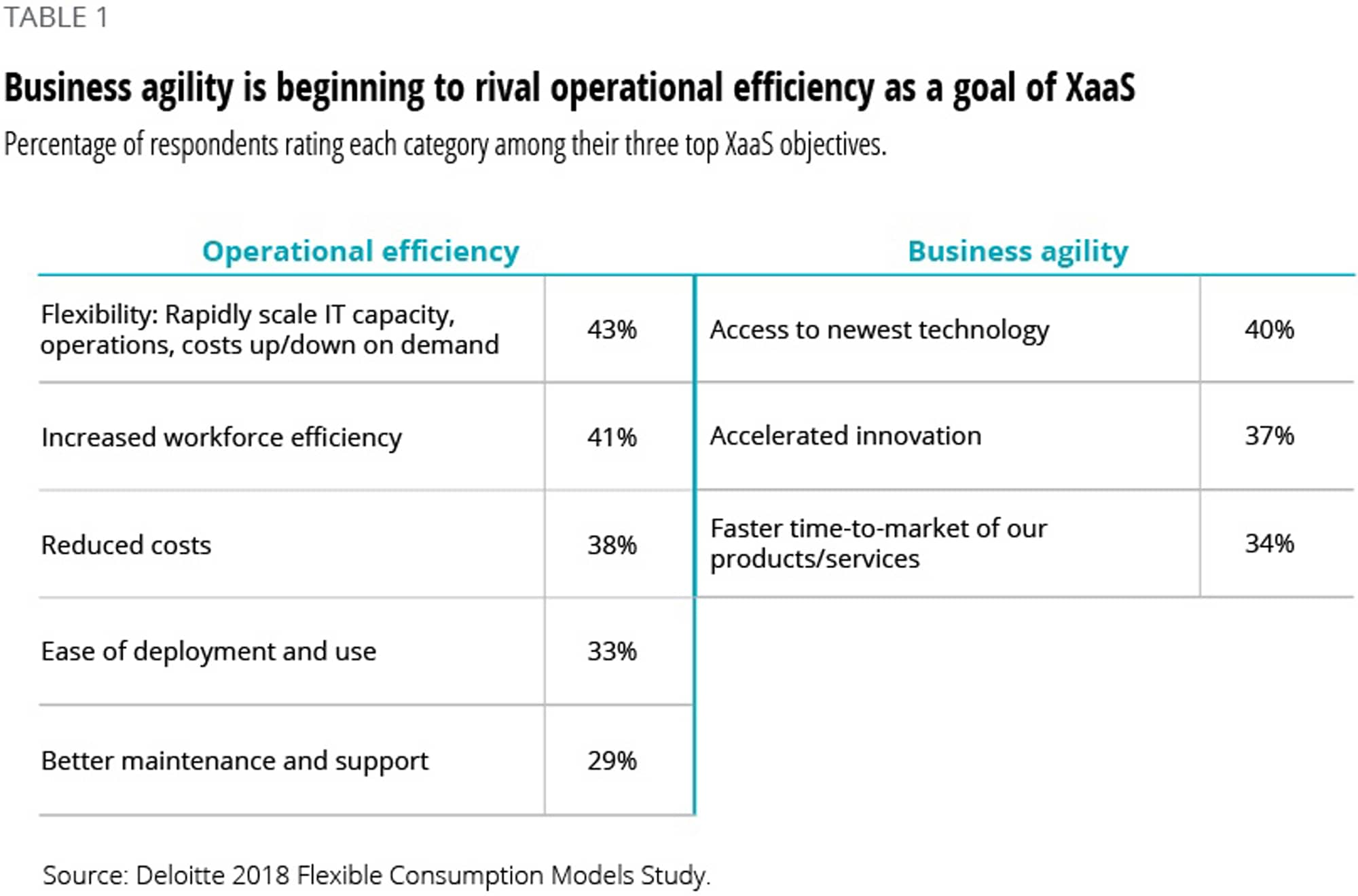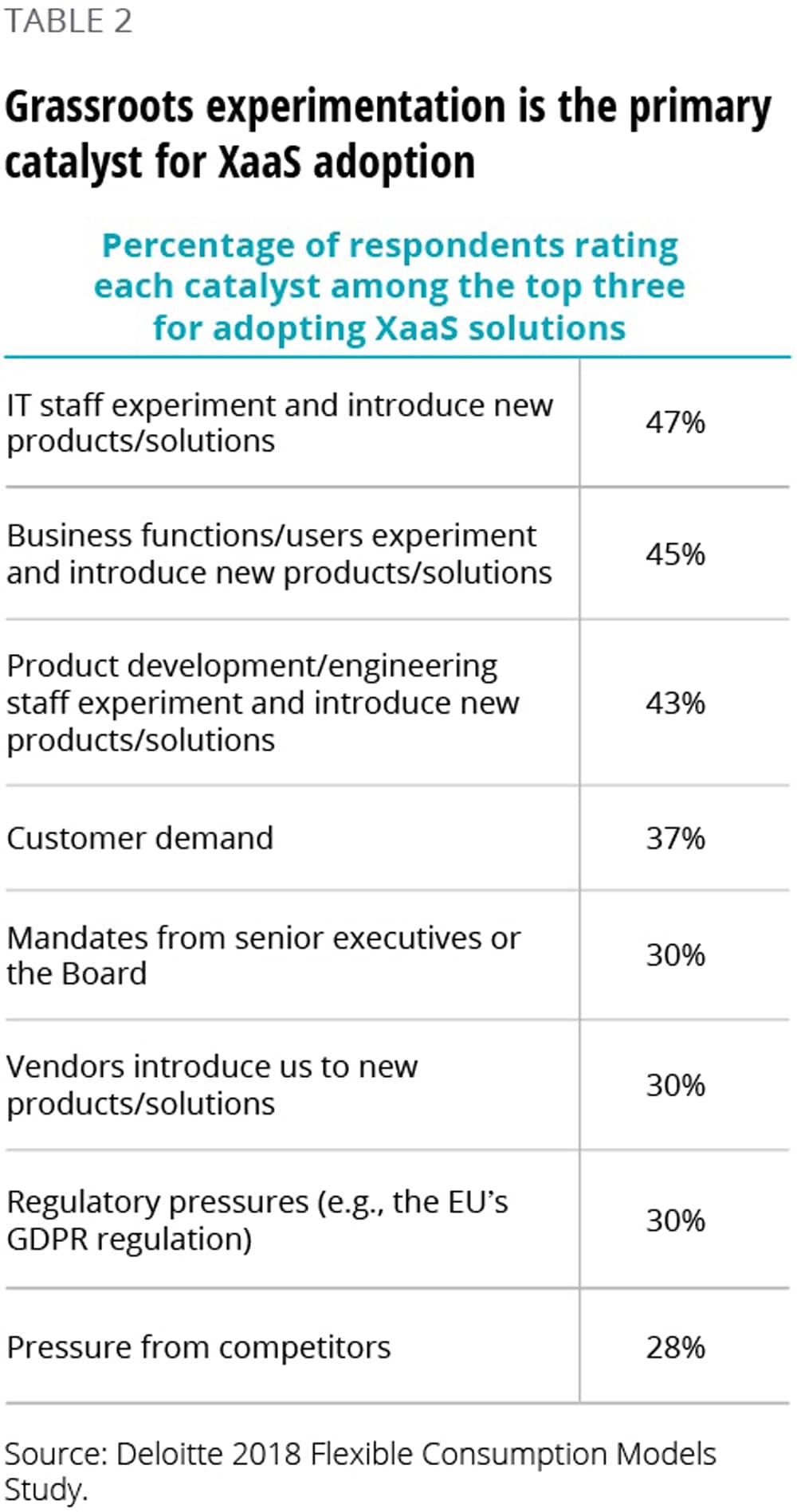
Accelerating agility with everything-as-a-service IT providers are shifting from traditional models to XaaS flexible consumption models
17 September 2018
 Gillian Crossan United States
Gillian Crossan United States Susanne Hupfer United States
Susanne Hupfer United States Jeff Loucks United States
Jeff Loucks United States Gopal Srinivasan United States
Gopal Srinivasan United States
How to make a company more agile? Increasingly, enterprises are moving from traditional purchasing of technology to everything-as-a-service. Our new survey shows how companies are benefiting from XaaS—and where they’re struggling.
Today’s fast-paced, disruption-driven marketplace often drives an increased need for agility. To thrive, companies should be able to see around corners, make quick course corrections, and harness technology to reimagine business models and reinvent how to deliver value to customers.
Consequently, many enterprise IT providers are shifting to a flexible consumption or everything-as-a-service (XaaS) model. With this approach, products and services are paid for based on usage—as opposed to the traditional IT model that involves an up-front purchase or licensing.
Learn More
Download the full report or create a custom PDF
Read How technology OEMs can guide channel partners into XaaS
View more content for the Telecom, Media & Entertainment sector
Subscribe to receive related content
Explore the cloud innovation charticle
To learn more about how companies are adopting and gaining value from flexible-consumption/XaaS models, Deloitte surveyed 1,170 IT and line-of-business professionals from large US companies that consume at least 15 percent of their enterprise IT on an XaaS basis. For a comprehensive look at the Deloitte 2018 Flexible Consumption Models Study, download our full article, Accelerating agility.
Three key insights from our study:
- Companies see XaaS as driving not only efficiency but, increasingly, business agility.
- Flexible consumption is making technology—and innovation—more broadly available.
- Issues of data security, integration, and cost are hindering XaaS efforts.
Business agility rivals efficiency as a key benefit of XaaS
XaaS can help companies get nimbler: Our survey indicates that business agility and innovation are well on their way to surpassing operational efficiency as primary drivers of XaaS adoption.
For example, 40 percent of respondents say “access to newest technology” is a key goal when choosing XaaS (table 1). In addition, for companies where more than three-quarters of the enterprise IT is XaaS, and in companies that have been using flexible consumption for more than three years, “accelerated innovation” has overtaken “reduced costs” as a goal for their XaaS initiatives. What’s more, seven in 10 companies report that XaaS is “very important” or “critically important” to their organization’s business success.

Of course, operational efficiency remains a clear motivation for XaaS adoption. The top overall motivator is flexibility—the ability to quickly scale IT capacity, operations, and associated costs up or down on demand, as needs change. Increased workforce efficiency is a close second objective, and it’s easy to understand why: Seventy-one percent of companies report that XaaS allows them to reduce time spent on IT maintenance and upgrades—now squarely on the shoulders of the service provider. An equal number say that XaaS enables them to transition their IT staff to more important tasks, such as helping the business to innovate.
Sixty-one percent of companies report that they’re mostly/fully achieving accelerated innovation with XaaS. Three-quarters indicate that flexible consumption helps them rapidly design, develop, and deploy new products/services; an equal number note that XaaS helps them reinvent business processes. Seven in 10 say that XaaS has led to new business models.
With the benefits it confers, XaaS no longer appears to be optional: Companies that don’t incorporate it may risk falling far behind the competition. Thirty-nine percent of companies report that XaaS adoption helps them catch up to or keep pace with their competitors, and another 32 percent believe it helps them edge slightly ahead. Twenty-eight percent believe their use of flexible consumption is giving them a sizable lead.
XaaS is democratizing innovation
Innovation acceleration with XaaS is emerging as an essential part of many companies’ strategic playbooks, particularly for the C-suite. A key factor contributing to that acceleration is democratization of innovation—making new technologies and tools more broadly and easily accessible, getting them into the hands of more diverse users across organizations, and fostering experimentation.
In our survey, seven in 10 companies report that XaaS reduces their cost of entry for adopting products/services; an equal number say that flexible consumption allows them to access a product or solution that otherwise would be too expensive. XaaS also enables companies to deploy new technologies without hiring specialized internal IT talent. Indeed, eight in 10 companies report that XaaS gives them quicker access to the latest technologies and innovative capabilities.
With the emergence of XaaS, the relationship between IT and the rest of the business is evolving. In many cases, the IT department no longer has a monopoly on providing technology to the organization: Seventy-one percent of surveyed companies report that their IT department now provides a framework and guidelines that allow business users to buy and use XaaS on their own. Seventy-four percent agree that the IT department functions as an “IT orchestrator” by evaluating, procuring, and managing new XaaS options for the organization.

Flexible consumption often fosters greater experimentation in organizations, by a broader set of users than ever before. Seventy-five percent of respondents say XaaS makes it easier and faster for them to prototype and experiment with novel solutions, and quickly evaluate outcomes. In fact, the top impetus for organizations to adopt XaaS solutions is grassroots experimentation—and not by only the IT department (table 2).
Data security, integration, and cost issues hinder XaaS efforts
While XaaS is extremely popular and can deliver benefits in spades to organizations, challenges remain. Topping the list are data security and privacy concerns, integration/interoperability/IT management challenges, and cost issues; these outweigh challenges relating to regulatory compliance, skills, product features, customizability, and vendor-related problems.
XaaS cost concerns present a conundrum. On one hand, seven in 10 respondents say their organization’s XaaS adoption has generated a better ROI than traditional IT, and the same number report that XaaS adoption has generally resulted in a lower total cost of ownership. Yet over one-third of companies still rate cost concerns as a top-three challenge. Among those who do, 45 percent report that their XaaS costs are difficult to predict and budget for; 42 percent say XaaS costs are greater than anticipated; and 34 percent indicate their renewal prices increased unexpectedly. Forty-four percent say duplicative costs are an issue—they’re continuing to pay for traditional IT while also paying for XaaS.
Among respondents who cited “integration, interoperability, or IT management challenges” as a top-three issue, 43 percent say they have difficulty transitioning away from highly integrated traditional IT solutions, and 39 percent mention difficulty integrating XaaS solutions with their traditional IT. Knitting together and managing various XaaS solutions also represents an obstacle: Forty percent say they’re facing integration or interoperability problems with their various XaaS solutions; about the same number specifically point to data-sharing difficulties.
New regulations are causing 71 percent of our survey respondents to re-examine the data handling associated with their XaaS solutions, though 69 percent believe they have adequate processes and policies to deal with data security for XaaS. Data security and privacy concerns are reflected in where companies choose to keep their data when using Xaas: About four in 10 say they keep less-sensitive data (XaaS usage data and nonpersonal organizational data) mostly or fully in the cloud, while only one-third keep customer, financial, or personal data mostly or fully in the cloud. Most companies (55 percent) say it’s entirely or somewhat more the responsibility of their own organization to ensure data security in XaaS initiatives (figure 1); 35 percent regard data security as a joint responsibility of their organization and the service provider.

The time is now
Our survey results make one thing clear: When it comes to accessing new technological capabilities as part of companies’ digital transformation, many executives want them to be based on flexible consumption. They recognize that XaaS-driven models may be a key to boosting business agility, innovation, and operational efficiency. If you’re a technology company and still trying to sell under old business models, you’ll likely need to make changes to remain competitive.
For a comprehensive look at the Deloitte Flexible Consumption Models Study, download our full article, Accelerating agility. |




